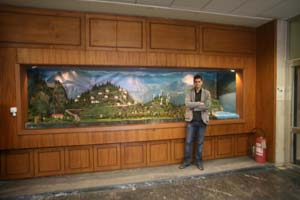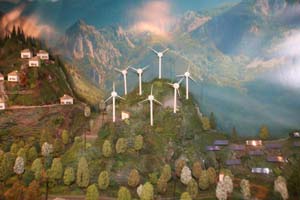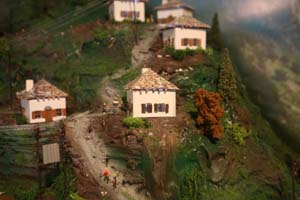ARCHITECTURAL REVIEW

19 October, 2006
An energy microcosm
A serious problem, may the most important, is the exhaustion of the non-renewable energy resources in global level (petroleum, natural gas, coal, etc.) that can easily lead the planet to a power crisis. The principal reason of that is our almost absolute dependence on these resources. 
By the coming of 21st Century, the man was put into a new orbit of scientific research and perception of the world. A lot of problems are coming up continuously in our quotidian life as a result of the past generations’ bad management. Unfortunately, our ancestors didn’t know the meaning of “sustainable develepment”, not even as a technical term i could say, and now we must restore their faults, which many in most of occasions are so tragic and with grave impact on society.
A serious problem, may the most important, is the exhaustion of the non-renewable energy resources in global level (petroleum, natural gas, coal, etc.) that can easily lead the planet to a power crisis. The principal reason of that is our almost absolute dependence on these resources.
Indisputably, there cannot be life without energy. Apart from that, most of countries of the world are looking for new energy sources, which are environmentally beneficial, renewable and they can get managed based in the rule of sunstainable development.
With that perspective, the Greek Electricity Public Undertaking (EPU) cross the threshold of the new millennium and since now it developped a big power programme based on the use of Renewable Energy Sources (RES), which is always expanded with European Union’s and national private operators’ help.
As EPU wanted, and especially its departement of Volos’ city, to pass more intensly in consumer’s society conscience the necessity of using RES in our life and to make known its valuable work in this sector, it decided the construction of a model in the central builiding of Volos EPU where there will be shown the electricity’s production using RES.
So, in the beginning of October 2005, Volos EPU’s administration got in touch with me, after the exhortation of my professor from the univercity Mr Aris Sapounakis, to propose me the realization of its idea by constructing a model, knowing that many years now i occupy myself with model constructions and i am very good in that faculty.
Immediately and without second thought i accepted their very interesting proposal, possessed of a feeling of challenge and enthusiasm, as the place would host the model was really wide and it would be the first time i would make a model with such dimensions. Besides, cause the subject of energy and environmental design consists one of the subjects of my studies, my enthusiasm came bigger.
The model’s main subject is the electricity’s procuction from RES (wind energy, solar energy and hydroelectric power), with construction of the equivalent production units (wind park, solar park and pondage power station), the disposal of electricity through a medium-voltage power grid, and, finally, the electricity consumption by a traditional human settlement. As for the dimensions of the model, these are 4.50mX1.50mX1.30m.
At the end of the same month i began the contsurction, which hold till the beginning of May 2006, namely about six months. I can say that this particular period was very tiring and difficult for me because most of time i was working up to 15 hours per day to complete some pieces of the model. Moreover, i applied some pioneer techniques - will get analysed below – which put up further the difficulty level of the construction.
The pionner techniques i mentioned before concern the use of mechanical elements in the model with the purpose of a more realistic representation of reality, so that even the most simple spectator could understand perfectly the electricity’s production from RES, electricity’s disposal and its consumption. Thus, the wind turbines of the wind park work like the real ones, the pondage power station uses real water, and the traditional human settlement’s houses are illuminated.



One more basic element, impressive i could notice, is the model setting’s changeover from the two-dimensional level to the three-dimensional one, which is easier perceptible from the mind of man.

The general geomorphological view of the model reminds us the greek reality. Further, the seascape is combined very harmoniously with the massifs and the plain between them, where the terriotories are cultivated. The illumination of the whole setting give us the sensation we are in deep afternoon hours when the sun sets and is needed the use of light in houses. I must mention here that the traditional human settlement, cause the vicinity of the city of Volos to Pelion moutain, projects the Pelion traditional architecture.




Ο μικρόκοσμος που μόλις παρουσίασα παρουσιάζει την ιδανική κατάσταση λειτουργίας του ενεργειακού συστήματος μιας χώρας. Η χρήση των ΑΠΕ είναι συνυφασμένες με την αειφόρο ανάπτυξη ενός τόπου. Η Ελλάδα έχει την τύχη να μπορεί να χρησιμοποιήσει αυτές τις μορφές ενέργειας για παραγωγή ηλ.ρεύματος, αλλά συνάμα έχει την ατυχία αδυναμίας εφαρμογής μιας σωστής ενεργειακής πολιτικής μέχρι σήμερα με στόχο την αυξανόμενη ενεργειακή ανεξαρτησία της χώρας και την ανάδειξη αυτής ως βασικό ενεργειακό παράγοντα τόσο των Βαλκανίων όσο και ολόκληρης της Ευρώπης.
Καλό θα ήταν να μη ξεχνάμε ότι το ενεργειακό μας μέλλον βρίσκεται στις ΑΠΕ και πολύ σύντομα θα κληθούμε να προβούμε σε περαιτέρω αξιοποίησή τους. Οι ΑΠΕ με μια σωστή διαχείριση μπορούν να επιλύσουν τα σημαντικά παγκόσμια ενεργειακά προβλήματα. Όσο για την Ελλάδα, έχω να πω ότι είναι κρίμα να μην αξιοποιούμε όπως θα έπρεπε τη πολύτιμη φυσική μας κληρονομιά (αέρας, ήλιος, νερό) τη στιγμή που άλλες χώρες, όπως η Γερμανία, βασίζονται όσο το δυνατόν περισσότερο στις ΑΠΕ.
Dimitrios K. Kalesopoulos
Engineer of Planning
& Regional Development
University of Thessaly
Adress: Olimpiados Str, 14a, 38222, Volos
E-mail: dkalesop@uth.gr
dimitrioskalesopoulos@hotmail.com
Related articles:
- Freiburg ( 28 May, 2013 )










